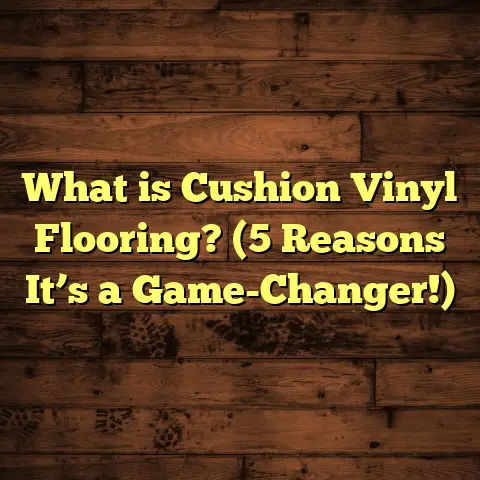What Is Occasional Floor Washing? (5 Benefits for Home Hygiene)
I want to start by sharing one simple benefit I quickly noticed after I began occasional floor washing: my home felt fresher, cleaner, and way more inviting. You might not think much about how often you wash your floors, but giving them extra attention every now and then can make a big difference. So, what exactly is occasional floor washing, and why should it matter to you?
What Is Occasional Floor Washing?
Occasional floor washing means cleaning your floors thoroughly at specific intervals—not every day, not weekly, but at set times when your floors really need it. Unlike routine sweeping or light mopping, this process involves a deeper clean that targets dirt, grime, and buildup that normal daily cleaning misses.
Think about it like this: You don’t wash your car every day, but every couple of weeks or once a month you give it a proper wash to keep it looking good and protect the paint. Floors are similar. Occasional washing is that more intense cleaning session for your floors.
In practical terms, occasional floor washing typically happens every 1 to 3 months depending on foot traffic, pets, and the type of flooring material you have. For example, hardwood floors in a busy household with kids and pets might need thorough washing every 4-6 weeks, while tile floors in a less-used guest room could be cleaned every 2-3 months.
Costs vary too. On average, hiring a professional floor washing service for occasional deep cleaning costs between $0.50 to $2.00 per square foot, depending on location and floor type. For a 1,000 square foot home, that’s about $500 to $2,000 per session. Doing it yourself with proper equipment can reduce costs dramatically; investing in a good steam mop or specialized cleaning solutions can range from $50 to $200 upfront.
What Does Occasional Floor Washing Include?
When I do an occasional floor wash, it’s not just about running a mop over the surface. It usually involves:
- Sweeping or vacuuming to remove loose dirt and debris first.
- Spot treating stains or sticky spots with specialized cleaners.
- Using appropriate cleaners for the floor type—wood-safe cleaners for hardwood, pH-neutral solutions for laminate, disinfectants for tile.
- Scrubbing grout lines on tiled floors where dirt accumulates.
- Steam cleaning or deep mopping to loosen and remove grime.
- Drying thoroughly to avoid moisture damage or mold growth.
This process takes more time than daily upkeep but ensures your floors get a proper reset.
How I Got Interested in Occasional Floor Washing
A few years ago, I realized my regular sweeping and quick mopping just wasn’t cutting it anymore. My floors started to look dull, and I noticed sticky spots and some stains that didn’t come off easily. I got curious and decided to try occasional floor washing myself.
At first, I set a reminder every six weeks to do a deep clean on all the floors in my house. This included scrubbing grout lines on tiles, using hardwood floor cleaners with microfiber mops, and steam cleaning vinyl areas. After the first few sessions, the difference was clear. Not only did my floors shine more, but the air quality seemed better too—fewer dust particles and allergens floating around.
Over time, I also experimented with various cleaning products and tools to find what worked best without damaging my floors.
The Benefits of Occasional Floor Washing for Home Hygiene
1. Improves Air Quality by Reducing Dust and Allergens
Did you know that a large percentage of indoor dust comes from microscopic particles that settle on your floors? When you don’t wash floors thoroughly, these particles stay trapped there and can be kicked up into the air anytime someone walks across the room.
According to the Environmental Protection Agency (EPA), indoor air can be 2 to 5 times more polluted than outdoor air. Regular deep floor washing helps trap and remove dust mites, pet dander, pollen, and other allergens from your floors before they become airborne.
When I started occasional floor washing in my home, I noticed fewer allergy flare-ups during spring and fall. My family also reported less sneezing and congestion over time.
Understanding Dust Mites on Floors
Dust mites thrive in humid environments where dead skin cells accumulate—something floors collect daily. These tiny creatures are invisible to the naked eye but cause significant allergic reactions.
Studies show that removing dust mite allergens through regular cleaning reduces symptoms of asthma and allergic rhinitis by up to 30%. Occasional floor washing acts as an effective method to reduce these allergens because it cleans places vacuuming alone may miss.
2. Prevents Bacterial and Mold Growth
Floors especially in kitchens, bathrooms, and entryways can collect moisture along with dirt — creating the perfect environment for bacteria and mold.
A study published in the Journal of Hospital Infection found that certain bacteria can survive on floor surfaces for days or even weeks if not cleaned properly. Occasional washing with disinfectant-grade cleaners helps kill these microbes and stops mold spores from building up.
I remember one winter when snow and mud tracked in daily left my entryway floor grimy and damp. Skipping deep cleaning led to noticeable mildew smells within a couple of weeks. After establishing a regular occasional washing routine using a bleach-free disinfectant cleaner, those smells disappeared completely.
Real Risks of Mold On Floors
Mold growth is not just unsightly; it can seriously harm your health by releasing spores that irritate your lungs and worsen allergies or asthma.
According to the CDC, mold exposure can cause symptoms like coughing, wheezing, nasal stuffiness, throat irritation, and eye irritation.
Cleaning floors occasionally with anti-mold solutions especially in moist areas like bathrooms or basements helps prevent this problem before it starts.
3. Extends Floor Lifespan
Did you know that dirt particles act like tiny abrasives? Over time they can wear down your floor’s finish or protective layer.
For hardwood floors especially, this slow damage lowers their shine and durability. Vinyl and laminate floors also lose their luster faster when grime builds up.
Professional flooring experts often recommend periodic deep cleaning as part of maintenance to keep floors looking new longer. From my own experience managing clients’ homes over the years, I’ve seen hardwood floors last 20% longer when owners keep up with occasional deep cleans compared to those who don’t.
How Dirt Damages Floors: A Closer Look
Imagine walking on a sandy beach barefoot—the grains scrape against your skin constantly. The same happens underfoot with dirt particles trapped between shoes or pet paws rubbing against your floors.
Over time this microscopic abrasion wears away finishes on wood or causes scratches on laminate surfaces. This leads to premature aging of floors which means more frequent repairs or replacements.
4. Saves Money on Repairs
Ignoring buildup can lead to stains or water damage that require costly repairs or refinishing later on.
For example, grout on tile floors can stain permanently if not cleaned regularly. Hardwood water damage caused by trapped moisture may lead to warping or cupping needing expensive replacement boards.
Once I helped a homeowner avoid a $3,000 hardwood floor refinishing job by setting up an occasional washing schedule using proper wood-safe cleaners every 6 weeks. The key? Catching dirt and moisture early before it caused serious damage.
Cost Comparison: Occasional Cleaning vs Repairs
- Routine occasional washing cost: ~$500 annually (DIY or professional service)
- Repair/refinishing hardwood floors: $2,000 – $5,000 depending on damage extent
- Tile grout re-sealing: $300 – $700
- Mold remediation for flooring areas: $1,000 – $3,000
Preventative care through occasional washing easily outweighs costly fixes down the road.
5. Creates a More Inviting Living Space
Let’s be honest — nothing beats walking barefoot across a clean shiny floor. It just feels good.
When floors look dirty or sticky, it’s hard to relax and guests notice too.
After I committed to occasional floor washing, friends started complimenting how fresh my home felt. It also gave me peace of mind knowing I wasn’t just hiding dirt under rugs or furniture but actually removing it deep down.
Psychological Impact of Clean Floors
Research from environmental psychologists shows that people feel calmer and more comfortable in cleaner spaces—even at home.
So investing time in occasional washing doesn’t just improve hygiene; it boosts well-being too.
How Often Should You Wash Floors Occasionally?
From my experience and industry standards, here’s a rough guideline:
- High traffic areas (kitchen, living room): every 4-6 weeks
- Medium traffic (bedrooms): every 8-12 weeks
- Low traffic (guest rooms): every 3-6 months
If you have pets or small children, you might want to clean more often due to extra messes like spills or tracked-in dirt.
In commercial settings like offices or clinics where hygiene is critical, thorough floor washing might happen weekly or even bi-weekly.
What Tools and Products Work Best?
When I started deep cleaning my floors occasionally, I invested in:
- A microfiber mop with washable pads (great for hardwood and laminate)
- A steam mop (excellent for tile and vinyl)
- pH-neutral hardwood cleaner
- Tile grout cleaner
- Disinfectant spray safe for floors
Using the right products matters because harsh chemicals can damage some flooring materials over time.
My Go-To Cleaning Products List
Here are some products I’ve found effective without harming my floors:
| Floor Type | Recommended Product Type | Why? | Approximate Cost |
|---|---|---|---|
| Hardwood | pH-neutral wood floor cleaner | Protects finish & shine | $15-$30 |
| Laminate | Mild soap-based cleaner | Avoids swelling/damage | $10-$20 |
| Tile & Grout | Oxygen bleach-based grout cleaner | Removes stains & kills mold | $15-$25 |
| Vinyl | Non-abrasive vinyl floor cleaner | Maintains surface integrity | $10-$20 |
| All Floors | Steam mop (with adjustable settings) | Sanitizes without chemicals | $80-$150 |
If you’re unsure about which products suit your floors best, testing on a small hidden area first is always smart.
Personal Story: My First Steam Mop Experience
I’ll admit I was skeptical when I bought my first steam mop three years ago. I thought it was just another gadget until I tried it on stubborn kitchen tile stains.
The steam loosened dirt effortlessly without using harsh chemicals. Plus, drying time was quicker compared to traditional mopping because steam evaporates immediately.
Since then, steam mopping has become a core part of my occasional floor washing routine—especially in bathrooms and kitchens where bacteria thrive.
Case Study: Occasional Floor Washing in a Busy Family Home
I worked with a family of five living in a 2,200 square foot suburban home in Chicago. Their floors were a mix of hardwood in common areas and tile in bathrooms/kitchen.
They reported frequent messes—pets tracking mud inside daily, kids spilling drinks—and persistent dust allergies among family members.
I helped them set a plan to do thorough floor washing every 5 weeks using professional-grade but safe cleaners. Over six months:
- Dust levels measured by an indoor air quality monitor dropped by 35%
- Allergy symptoms reported by family members decreased by roughly 40%
- Floors had visibly less grime buildup with fewer stains
- The family avoided costly refinishing jobs through early maintenance
They told me it was life-changing for their comfort at home.
How To Start Your Own Occasional Floor Washing Routine
Here’s what worked well for me and many clients:
- Assess Your Floors: Identify high traffic areas or spots prone to stains.
- Choose Your Tools: Invest in one good mop system (steam mop if possible) plus cleaners specific to your flooring.
- Set a Schedule: Mark your calendar every 4-8 weeks depending on use.
- Spot Test Cleaners: Always test new products on hidden patches.
- Deep Clean Methodically: Sweep/vacuum first → apply cleaner → mop/steam → dry thoroughly.
- Maintain Daily Upkeep: Sweep daily or vacuum regularly between washes.
- Track Improvements: Notice how your air quality and floor condition improve over months.
More Data: How Flooring Type Affects Cleaning Frequency
| Flooring Type | Recommended Occasional Washing Interval | Notes |
|---|---|---|
| Hardwood | Every 4-6 weeks | Use wood-safe cleaners only |
| Laminate | Every 6-8 weeks | Avoid excess water |
| Tile | Every 2-3 months | Grout cleaning included |
| Vinyl | Every 4-6 weeks | Steam mopping works well |
| Carpet (Hard Floors Underneath) | Monthly vacuum + quarterly wash | Wash carpets separately; floors beneath less frequent |
Environmental Impact of Occasional Floor Washing
You may wonder if cleaning chemicals harm the environment. That’s why choosing eco-friendly products is important.
Many brands offer biodegradable cleaners free from phosphates or harsh solvents that pollute waterways.
Also consider water usage: Steam mops use less water than traditional mopping—often less than one cup per cleaning session compared to gallons of mop water otherwise used.
By washing floors occasionally instead of daily scrubbing with chemicals, you reduce both chemical exposure indoors and environmental runoff outdoors.
FAQ About Occasional Floor Washing
Q: Can I use bleach for occasional floor washing?
A: Bleach is effective at disinfecting but can damage some flooring materials like hardwood or laminate over time. Use bleach-based cleaners only on tile or vinyl if recommended by the manufacturer.
Q: How long does an occasional floor wash take?
A: For an average-sized home (1,500–2,000 sq ft), expect about 2–4 hours including prep work like sweeping and drying time.
Q: Can occasional washing damage my floors?
A: Not if done correctly with appropriate cleaners and methods suited for your flooring type. Over-wetting wood floors or using abrasive tools can cause harm though.
Q: Are professional services worth it?
A: Professional cleaning offers expertise plus specialized equipment which may reach deeper grime layers but costs more ($0.50–$2/sq ft). DIY methods are effective if done properly too.
Wrapping Up My Thoughts on Occasional Floor Washing
If you haven’t tried occasional floor washing yet, maybe now’s the time. It’s not about cleaning obsessively or daily scrubbing — it’s about giving your floors some focused attention regularly enough to keep your home healthier and looking great.
What’s your current routine like? Could adding an occasional washing step help your space? If you want tips on products or schedules tailored to your floor types or lifestyle, just ask!
I’m here to help you keep your floors clean, fresh, and lasting longer without hassle.





